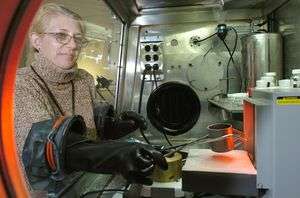New system could provide safer, cheaper, more detailed mammograms

A new ultra-high resolution mammography system that detects cancerous tumors with higher-quality images, more efficient radiation exposures and lower cost has been developed by a team of U.S. and German scientists.
Radiography is the oldest and most frequently used method for detecting internal masses in medical imaging. It allows doctors to save lives by discovering cancerous tumors or irregularities early.
Breast cancer deaths have been declining since 1990, but the disease annually kills 40,000 women. “Better imaging technology is crucial in lowering deaths and increasing early diagnosis and prevention,” said Jacqueline Johnson, a materials scientist at the U.S. Department of Energy's Argonne National Laboratory.
Johnson, in collaboration with Rick Lubinsky from New York and Stefan Schweizer from Germany, honed computer radiography technology to produce the Ultra-High Resolution Mammography System, which was recently honored with an R&D 100 award.
The system uses a glass-ceramic plate, which is transparent to lessen light scattering, and a readout device designed specifically to maximize the efficiency of the glass-ceramic material. The plates, made from a photostimulable phosphor, have many advantages over traditional photographic film and scintillating screens, such as reusability, wide dynamic range and direct digitization.
Although flat-panel-based digital radiography technology (DR) has started to surpass computer radiography (CR) in leading research hospitals, DR systems are much more expensive, and each individual detector in a room requires a separate DR detector. “The average hospital could still benefit greatly from a high-resolution system that enables early diagnosis of breast cancer but is affordable,” said Johnson.
In general radiography, the current conversion rate from analog to digital technology is about 50 percent, but it is less than 10 percent for mammography systems. However, the new system achieves as good or better resolution than screen or film, and it has the potential to greatly increase the use of CR for mammography. The technology also reduces the amount of chemicals used and the production of waste, which make the system attractive for other applications, including inspection of micro-electronic parts or X-ray diffraction analysis of biological materials.
Source: Argonne National Laboratory




















